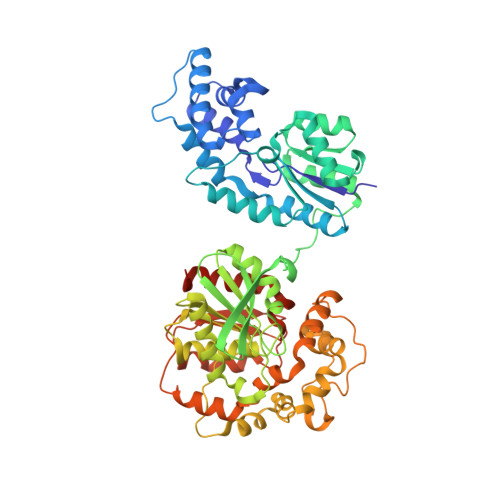Identification of N-ethylmethylamine as a novel scaffold for inhibitors of soluble epoxide hydrolase by crystallographic fragment screening
Amano, Y., Tanabe, E., Yamaguchi, T.(2015) Bioorg Med Chem 23: 2310-2317
- PubMed: 25862210
- DOI: https://doi.org/10.1016/j.bmc.2015.03.083
- Primary Citation of Related Structures:
4Y2J, 4Y2P, 4Y2Q, 4Y2R, 4Y2S, 4Y2T, 4Y2U, 4Y2V, 4Y2X, 4Y2Y - PubMed Abstract:
Soluble epoxide hydrolase (sEH) is a potential target for the treatment of inflammation and hypertension. X-ray crystallographic fragment screening was used to identify fragment hits and their binding modes. Eight fragment hits were identified via soaking of sEH crystals with fragment cocktails, and the co-crystal structures of these hits were determined via individual soaking. Based on the binding mode, N-ethylmethylamine was identified as a promising scaffold that forms hydrogen bonds with the catalytic residues of sEH, Asp335, Tyr383, and Tyr466. Compounds containing this scaffold were selected from an in-house chemical library and assayed. Although the starting fragment had a weak inhibitory activity (IC50: 800μM), we identified potent inhibitors including 2-({[2-(adamantan-1-yl)ethyl]amino}methyl)phenol exhibiting the highest inhibitory activity (IC50: 0.51μM). This corresponded to a more than 1500-fold increase in inhibitory activity compared to the starting fragment. Co-crystal structures of the hit compounds demonstrate that the binding of N-ethylmethylamine to catalytic residues is similar to that of the starting fragment. We therefore consider crystallographic fragment screening to be appropriate for the identification of weak but promising fragment hits.
Organizational Affiliation:
Drug Discovery Research, Astellas Pharma Inc., 21, Miyukigaoka, Tsukuba, Ibaraki 305-8585, Japan. Electronic address: yasushi-amano@astellas.com.
















